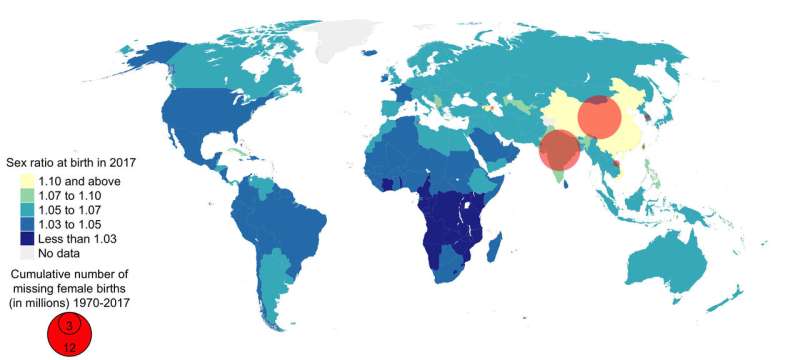April 16, 2019 report
Long-term study shows gender-based abortions lead to skewed gender population numbers

A team of researchers from Singapore, the United Nations Population Division, and the U.S. has found that abortions based on gender lead to larger-than-thought distortions in gender ratios. In their paper published in Proceedings of the National Academy of Sciences, the group describes their five-year study of population and gender ratios and what they found.
The researchers note the prior research has shown that the natural gender ratio for humans is approximately 100 female babies to 105 male babies. As yet it is still unknown why the ratio is not 50/50. Prior research has suggested that societal practices can change the ratio, as well. In this new effort, the researchers sought to better quantify the impact on populations of women choosing to abort a pregnancy based on gender. More specifically, they sought to find out what happens to gender ratios in populations when women choose to abort female babies.
To find out, the researchers embarked on a long-term study that involved gaining access to birth records, census information and survey responses for 202 countries, 12 of which were known to have experienced periods of societal pressure favoring male babies.
The researchers report that the largest differences in gender ratios were in China and India. In 2005 in China, during the time period with the largest observed difference, the ratio was approximately 100 female births to 118 male births. They note that the impact of such a large difference is now realized, as children born in 2005 are reaching reproductive age. They note also that although China lifted a law prohibiting more than one child per couple, population growth has continued to stagnate due to the lack of women to produce babies.
The researchers refer to the babies that were not born due to gender-based abortion as "missing females." They calculated that China currently has approximately 11.9 million missing females and India has approximately 10.6 million missing females. The grand combined total for all of the countries in the study came to approximately 23.1 million missing females. The researchers suggest that such calculations need to be taken into consideration when making population estimates in the future.
More information: Fengqing Chao el al., "Systematic assessment of the sex ratio at birth for all countries and estimation of national imbalances and regional reference levels," PNAS (2019). www.pnas.org/cgi/doi/10.1073/pnas.1812593116
Journal information: Proceedings of the National Academy of Sciences
© 2019 Science X Network


















